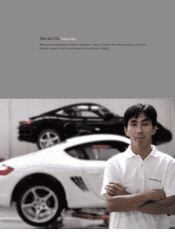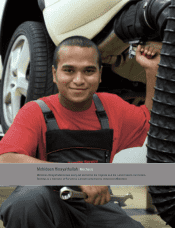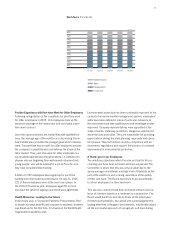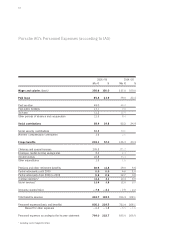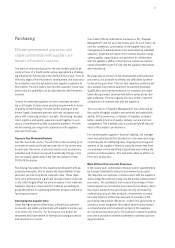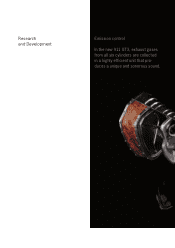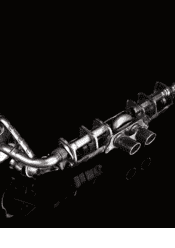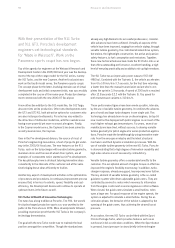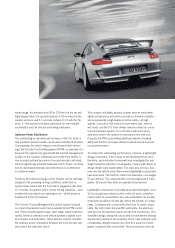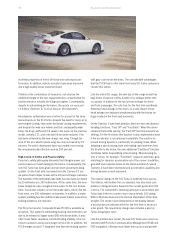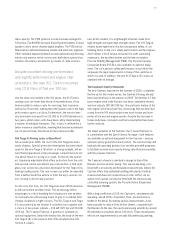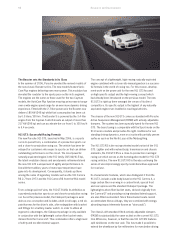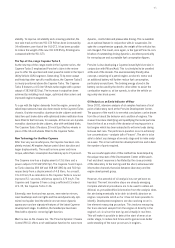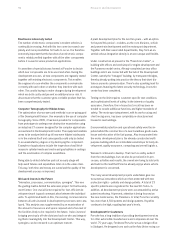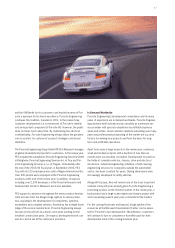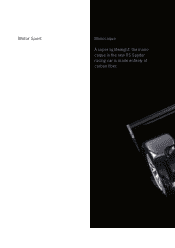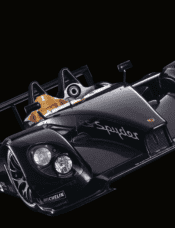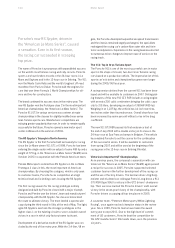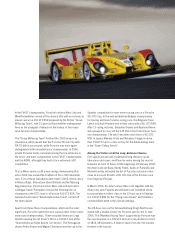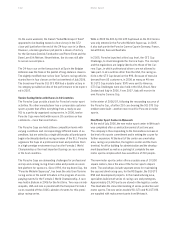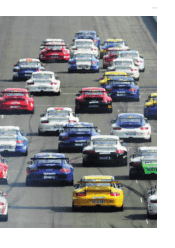Porsche 2005 Annual Report Download - page 95
Download and view the complete annual report
Please find page 95 of the 2005 Porsche annual report below. You can navigate through the pages in the report by either clicking on the pages listed below, or by using the keyword search tool below to find specific information within the annual report.93
data capacity. The PCM system’s screen has been enlarged to
5.8 inches. The BOSE® Surround Sound System features 13 loud-
speakers and a seven-channel digital amplifier. The PCM can be
fitted with an optional telephone module and electronic logbook.
Other standard equipment details include automatically dimming
interior and exterior mirrors and an anti-theft alarm system that
monitors the interior and exterior by means of radar sensors.
Despite excellent driving performance
and significantly improved engine char-
acteristics, the new 911 Turbo consumes
only 12.8 liters of fuel per 100 km.
Like the other new models in the 911 series, the 911 Turbo’s
running costs are lower than those of its predecessor. It has
been possible to reduce costs for servicing, fuel, insurance
and tax by 20 percent, making them the lowest costs in the high-
performance sports car class. Furthermore, the service inter-
vals have been increased from 20,000 to 30,000 kilometers or
two years, whilst repair costs have been cut by implementing
a number of individual measures. This, in turn, is reflected in a
better insurance classification, meaning that insurance premiums
are 33 percent lower than those for the previous model.
911 Targa 4: Driving under a Glass Roof
Since model year 1996, the roof of the 911 Targa has been
made of glass. Special protective tinted glass has been devel-
oped for the new Targa 4 (S) which, in strong sunlight, will en-
sure that temperatures in the passenger compartment do not
rise above those occurring in a coupé. An electrically-operat-
ed, steplessly-adjustable blind offers protection from the cold
and sun and can be operated in any roof position. A fold-open
glass rear screen has also been developed for the Targa 4 (S),
making loading easier. The rear screen can either be operated
from a button inside the vehicle or from the key’s remote con-
trol. Closing is electrically assisted.
For the very first time, the 911 Targa has been fitted exclusive-
ly with permanent all-wheel drive. This technology offers
advantages in critical handling-limit situations in wet weather,
on road surfaces with varying levels of grip or in sudden load
change conditions in tight corners. The 911 Targa 4 and Targa
4 S are powered by the familiar 6-cylinder boxer engines with
a choice of two power outputs – 239 kW (325 hp) and 261 kW
(355 hp). The 5-speed Tiptronic S gearbox is available as
optional equipment. Below the window line, the body of the new
911 Targa 4 (S) is the same as that of the all-wheel drive 911
Carrera 4 coupés.
Like all 911 models, it is a lightweight structure made from
high-strength and super-high strength steels. The 911 Targa 4
models boast high levels of active and passive safety. A con-
tributing factor to the car’s safety performance are the engines,
which deliver a lot of torque and power for swift overtaking
maneuvers, the excellent brakes and the latest-evolution
Porsche Stability Management (PSM). The Porsche Ceramic
Composite Brake (PCCB) is also available as optional equip-
ment. The car’s passive safety performance is such that it far
surpasses the legal requirements in many of the countries in
which it is sold. In addition, the new 911 Targa 4 (S) comes as
standard with six airbags.
The Cayman’s Sporty Character
The new Cayman, launched in the summer of 2006, completes
the line-up for this model series, the Cayman S having already
been launched back in the autumn of 2005. The familiar 2.7-liter
boxer engine used in the Boxster has been completely revised
and now outputs 180 kW (245 hp). One particular feature of the
new engine is the VarioCam Plus, technology that has been bor-
rowed from the 911 and provides even more torque and more
power at low and mid engine speeds. Despite this increase in
torque and power, emissions and fuel consumption have been
further reduced.
The latest evolution of the Tiptronic, the 5-speed Tiptronic S,
in combination with the Sport Chrono Package – both features
are available as optional equipment for the Cayman – ensures
optimum sporty gearshift characteristics. The electronically and
hydraulically-operated gearbox has variable gearshift programs
to facilitate an even more sporty driving style than was possible
with the previous Tiptronic.
The Cayman’s chassis is identical in design to that of the
Boxster, but has sportier tuning. This special uprating, com-
bined with a torsionally and flexurally-resistant body, means the
Cayman offers truly individual handling with plenty of safety
reserves but does not compromise on ride comfort. As an
option, the Cayman can also be fitted with the electronically-
controlled damping system, the Porsche Active Suspension
Management (PASM).
With a drag coefficient of 0.29, the Cayman is, aerodynamically
speaking, ahead of the competition. Here, the know-how is
hidden in the detail. By making various improvements, it has
been possible to reduce lift at all four wheels, compared with
the Boxster. At the rear, the new bi-plane wing extends by around
80 millimeters at speeds above 120 km/h. These aerodynamic
effects are supplemented by virtually full underbody paneling.


